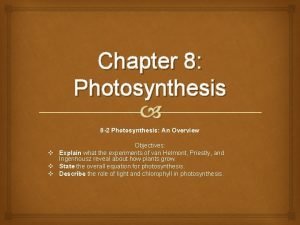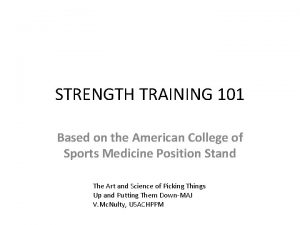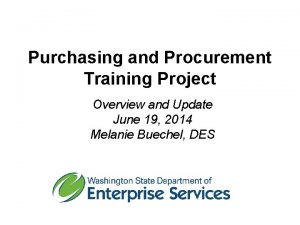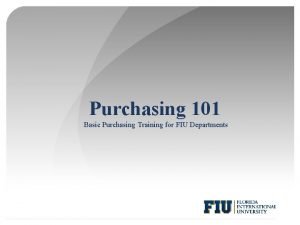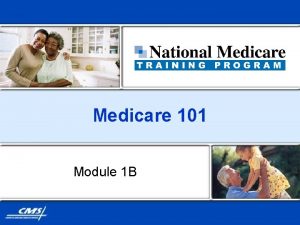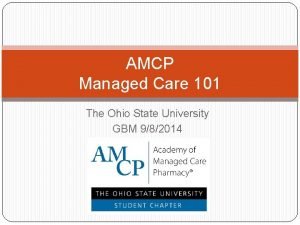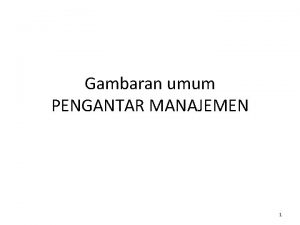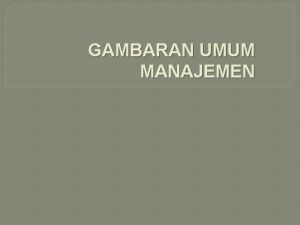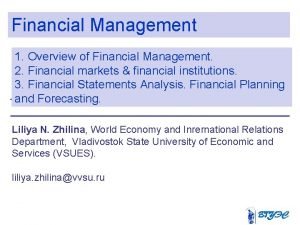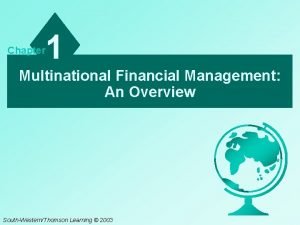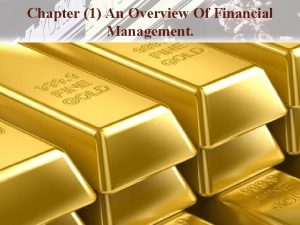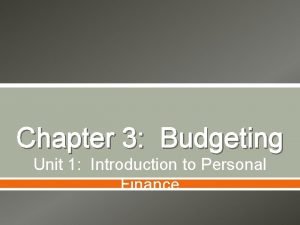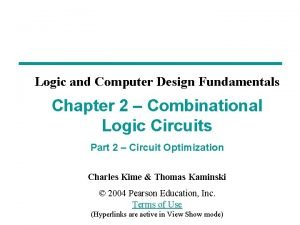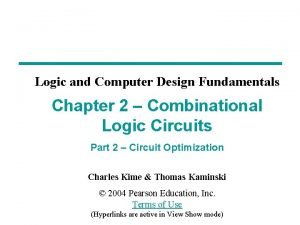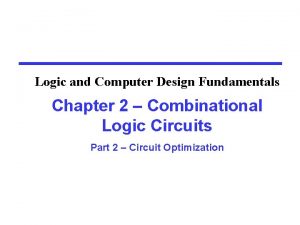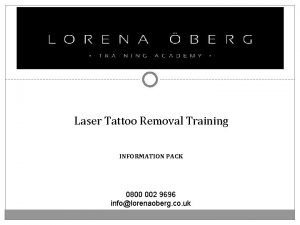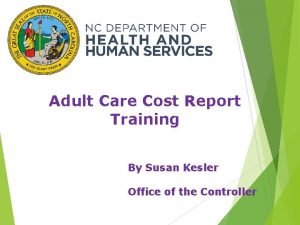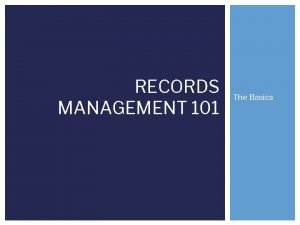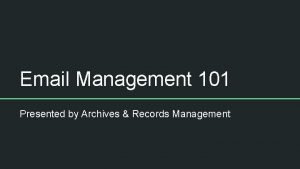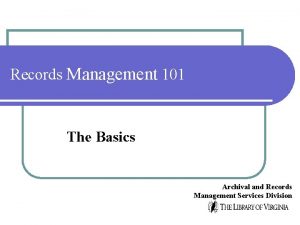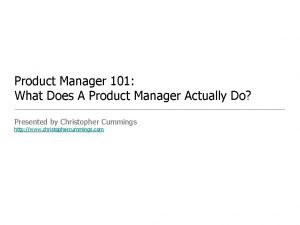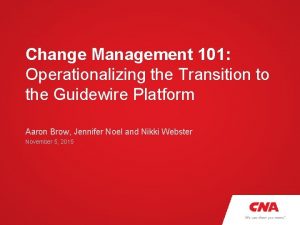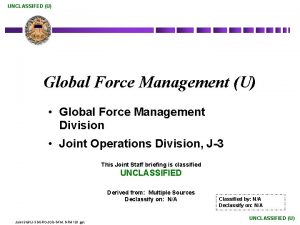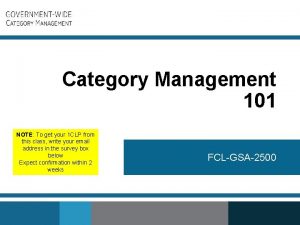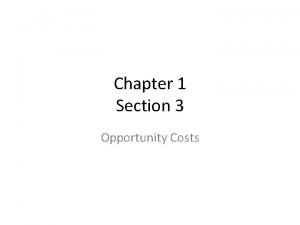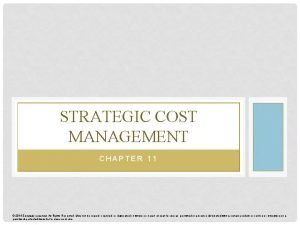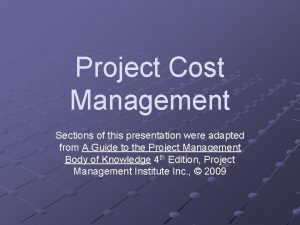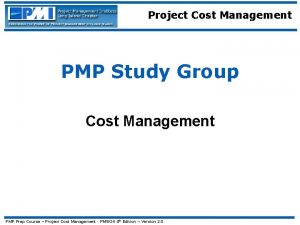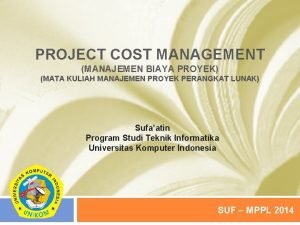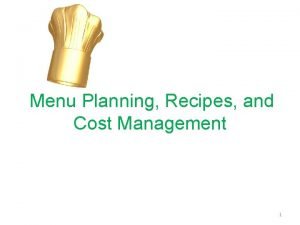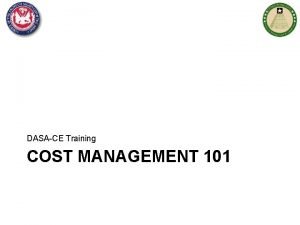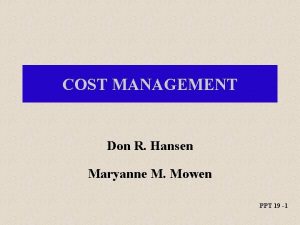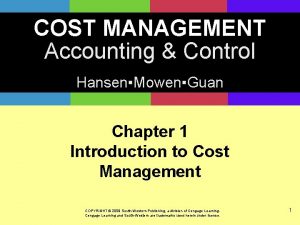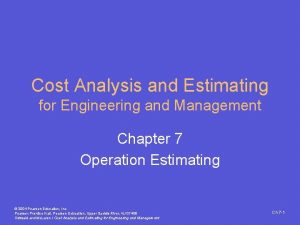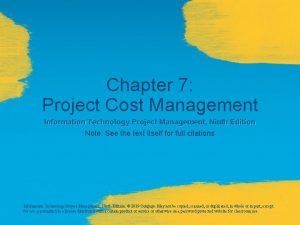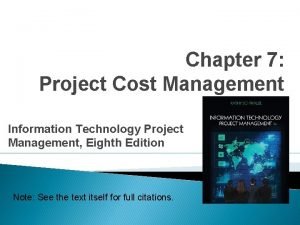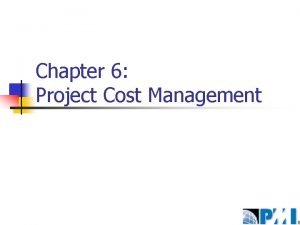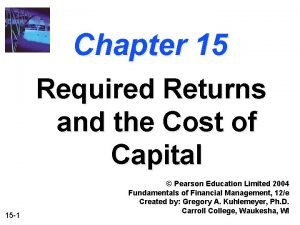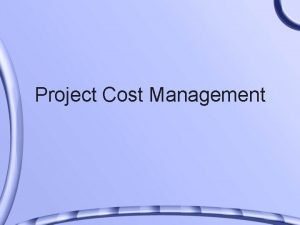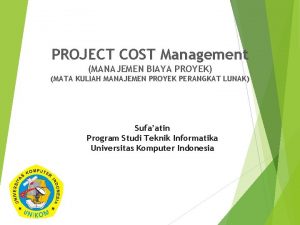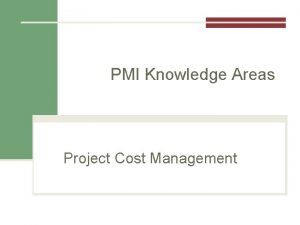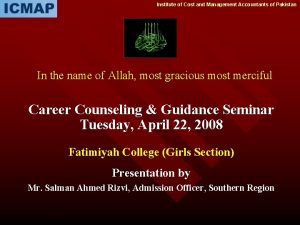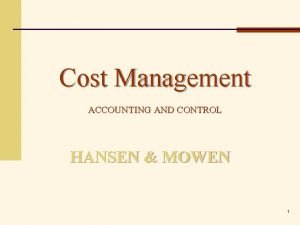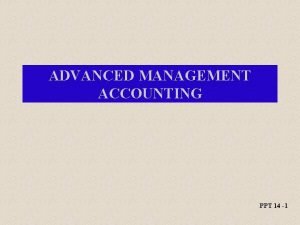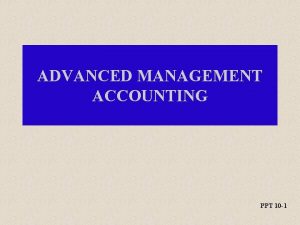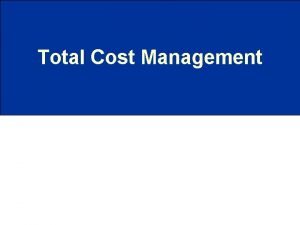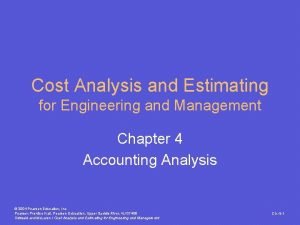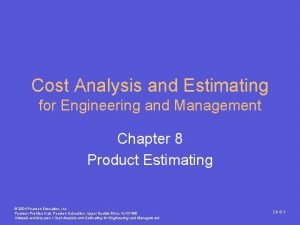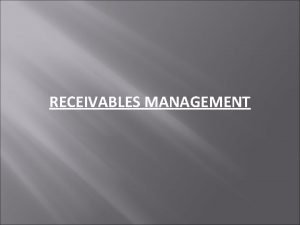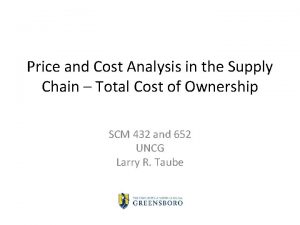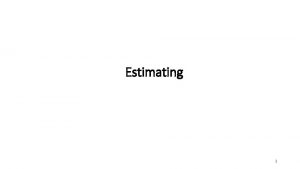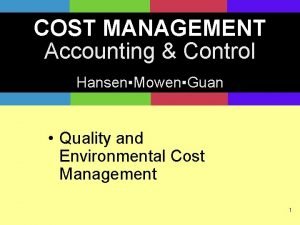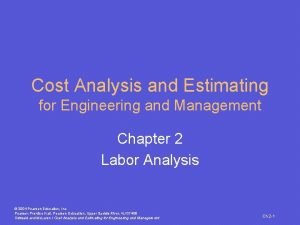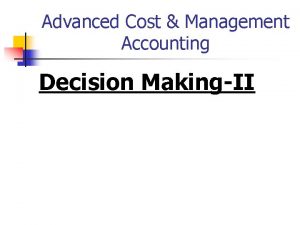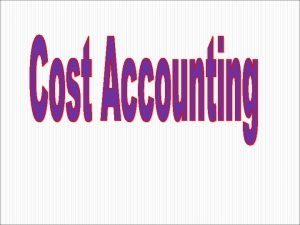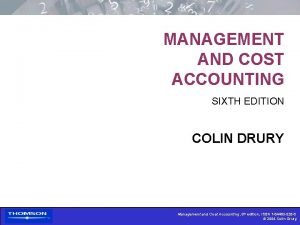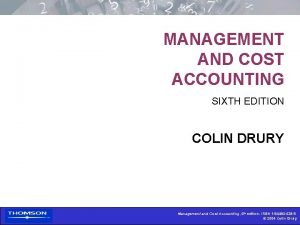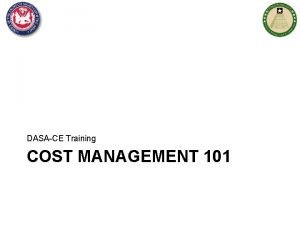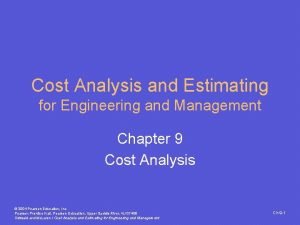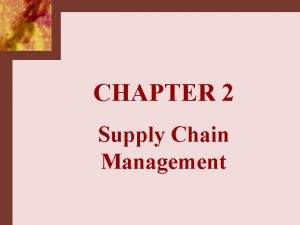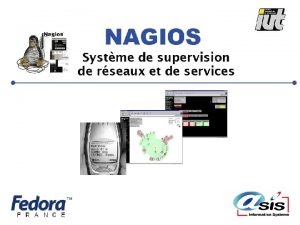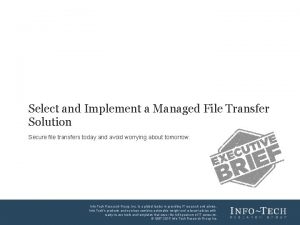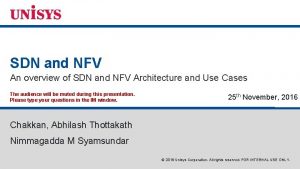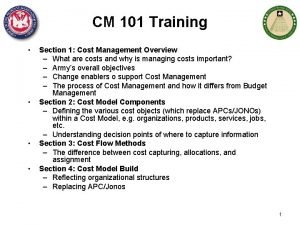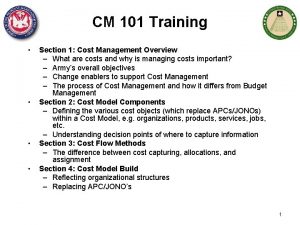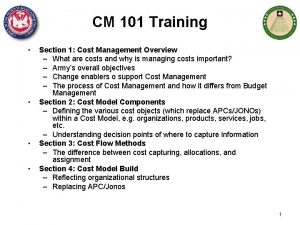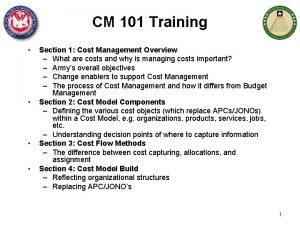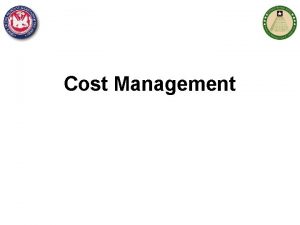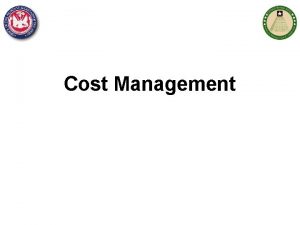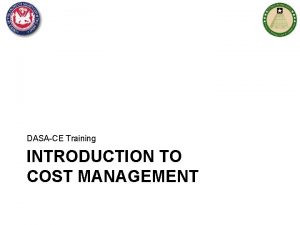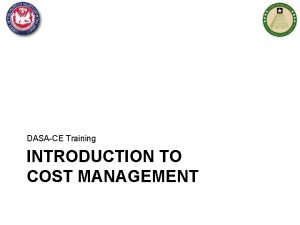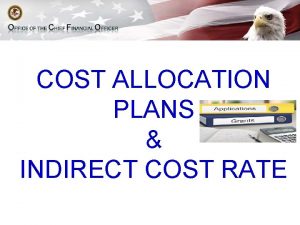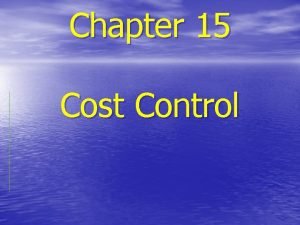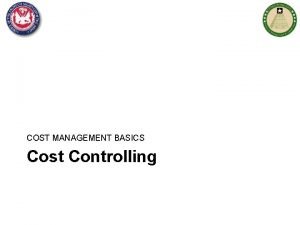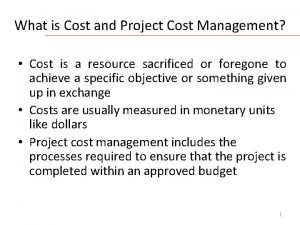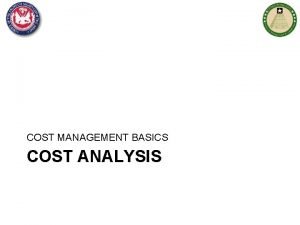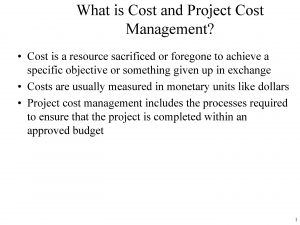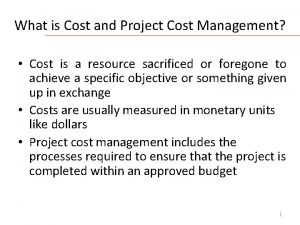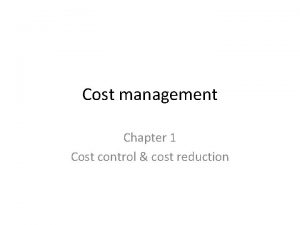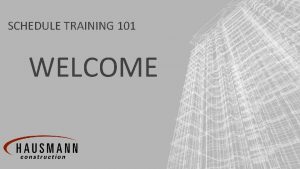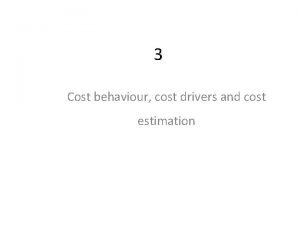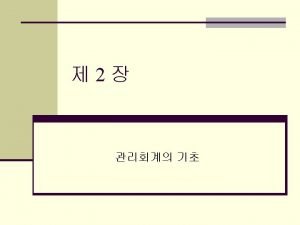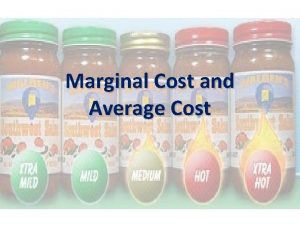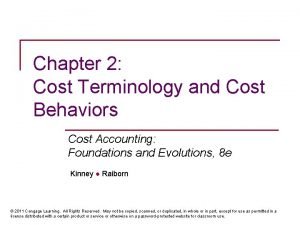CM 101 Training Section 1 Cost Management Overview


























































































































- Slides: 122

CM 101 Training • • Section 1: Cost Management Overview – What are costs and why is managing costs important? – Army’s overall objectives – Change enablers to support Cost Management – The process of Cost Management and how it differs from Budget Management Section 2: Cost Model Components – Defining the various cost objects (which replace APCs/JONOs) within a Cost Model, e. g. organizations, products, services, jobs, etc. – Understanding decision points of where to capture information Section 3: Cost Flow Methods – The difference between cost capturing, allocations, and assignment Section 4: Cost Model Build – Reflecting organizational structures – Replacing APC/JONO’s 1

Section 2 Objective & Agenda Section 2: Cost Model Components • Understanding of the master data available to define the cost model - Lesson 1: Lesson 2: Lesson 3: Lesson 4: Lesson 5: Lesson 6: Lesson 7: Lesson 8: Lesson 9: Cost Elements Cost Terms Cost Centers Activity Types Payroll & Labor Tracking WBS Elements Orders Business Processes Statistical Key Figures 2

The Army Cost Model Objects (Master Data) 3

Lesson 1: Cost Elements Objective(s): • To understand what the Cost Element cost object represents, key definition criteria (guiding principles), uses, and how defined for the Cost Model 4

SAFM-CE Army Cost Model Cost Element Definition: A Cost Element is the lowest level component for classifying costs and revenues (as negative costs) of a resource and indicates the category/type associated with a posting (e. g. allocation type, revenue, expense) • GFEBS replaces the concept of EORs with GL Accounts in Financials (FI), Commitment Items in Budgeting (FM) and Cost Elements in Cost Management (CO) 5

SAFM-CE Army Cost Model Guiding Principles for Cost Elements Principle #1: External Alignment to support external reporting requirements for financial reporting of P/L items. Principle #2: Transparency Provide the lowest level of transparency necessary for managing revenues/expenses not already supported within another data element Individual Transactions Manage Travel by Cost Center OMB Object Class 21 - Travel Flight Hotel 6100. 21 T 0 6100. 21 P 0 OC 21 Meal 6

SAFM-CE Army Cost Model Cost Element Uses • Capture actual costs (expenditures, imputed costs, allocations, etc. ) • Plan cost by organizations (Cost Centers), activity types or products/services • Reporting of individual expense categories or grouped together to support internal (management) and external (OMB/SFIS) reports • Move costs from one org/location to another: e. g. similar to some “cost transfers” currently performed • Primary (consumed from outside) versus Secondary (consumed from inside) • Maintain debit/credit integrity for expense related postings within the Controlling component of GFEBS 7

Primary Cost Elements • Expenditures externally sourced, such as most of today’s EORs (excluding the 2700 s) • Typically (but not necessarily e. g. , depreciation) indicative of cash out flows • Start with the USGL indicator, such as 6100 or 6400 for expenses • Are a 1: 1 match with the General Ledger Account utilized for Financial Accounting Director of Logistics (DOL) Cost Center: CIF Military Labor DOL Support Labor Material Contracts Travel Military Labor Facilities Examples: - 6100. 11 B 1 Civilian Base Pay - Full-time Permanent 6100. 11 B 3 Civilian Base Pay - Other than Full-time Permanent 6100. 21 T 0 TDY Travel 6100. 252 A Information Technology Services – Processing 6400. 13 H 0 VSIP TAX -15% Remittance to CSRDF $$$ $$$ CIV HR MIL HR 8

Secondary Cost Elements • Assigned/service fees to an object for consuming products/services providing by another object. (e. g. 2714 Shop Stock) • Non-cash outlays (would have occurred with the Primary Cost Element posting) • Start with a 9 series preface to indicate that they are not associated with the General Ledger, e. g. internal only • There are multiple types of secondary cost Military elements to support allocations, charge Labor outs, overhead surcharges, etc. Director of Logistics (DOL) Cost Center: CIF DOL Support Labor Material Contracts Travel Military Labor Facilities Examples: - 9000. 2714 MATERIAL SHOP STOCK 9300. 0100 LABOR CHARGE - REG 9300. 01 OT LABOR CHARGE - OT 9400. 0150 MILITARY LABOR CHARGE $$$ $$$ CIV HR MIL HR 9

Cost Elements Example Director of Logistics (DOL) Cost Center: CIF 9200. 0100 Military Labor Support Allocation $$$ 6100. 11 B 1 Full-Time Perm $$$ 6100. 26 XX Material $$$ 6100. 25 YY Contracts $$$ 6100. 21 T 0 Travel $$$ 9700. 0150 Mil Labor Imputed $$$ 9400. SQFT Facilities $$$ Total $$$$$ 9300. 0100 Labor Charge Reg 9400. 0150 Mil Labor Charge Total Over/Under Absorption - $$$$ CIV HR MIL HR 10

SAFM-CE Army Cost Model How Cost Elements are Defined • For Primary Cost Elements: – Started with EORs for both pay and non-pay – Evaluated information embedded in code/EOR – Determined if another GFEBS data element could hold that info and collapsed where possible (e. g. C-Type, Vendor, Type of Interest Payment) – Reviewed external reporting requirements such as OMB Object Classes, USGL, SFIS mappings – When a GL Account it determined a Primary Cost Element is also created with the exact same code – Once live, new Primary Cost Elements are typically rarely added and as needed to support external reporting 11

EOR crosswalk to GL Discussion • EORs will no longer be used in GFEBS; yet, the same information previously maintained through EORs will be supported via different methods 500+ 37 -100 Labor EORs C-type is removed from Accounts in GFEBS and reported via BI Labor Report GFEBS BI 60+ in GFEBS as: -FI GL Accounts -Primary Cost Elements -Commitment Items Labor Report by C-Type 12

SAFM-CE Army Cost Model How Cost Elements are Defined • For Secondary Cost Elements: – Determined types of cost allocations/ assignments to be supported (assumed all possible in GFEBS) – Determine internal management reporting detail needs, continues to expand with maturity – Identified impacts for budget/non-budget relevant in funds management – Secondary Cost Elements are constantly being added as assignments/allocations are updated/changed in order to provide transparency for management reporting 13

Cost Element Groups • Cost Elements can be grouped together to support – Reporting: e. g. all labor related primary cost elements into a group called Payroll Labor – Reconciliation: e. g. the primary cost element used to procure shop stock with the secondary cost element used to allocate shop stock to manage the under/over absorption – Allocations: e. g. allocating a combination of cost elements to multiple receivers – Hierarchies: e. g. by creating cost element groups within cost element groups a hierarchy is generated which can be utilized to meet OMB Object Class and SFIS reporting requirements OM B OCs 11 11. 3 11. 5 11. 7 12 13 21 … 14

Lesson 1: Wrap-Up • A Cost Element is the lowest level component for classifying costs and revenues (as negative costs) and indicates the category/type associated with a posting (e. g. allocation type, revenue, expense) • There are two types of Cost Elements: Primary and Secondary • Primary Cost Elements represent those obtained from the external market, the initial posting • Secondary Cost Elements represent costs incurred from within the Army • EORs and the EOR information will be supported via GFEBS through GL Accounts, Commitment Items, and Primary Cost Elements • Cost Elements can be grouped together to support internal and external reporting including to generate hierarchies such as OMB Object Class 15

Lesson 2: Cost Terms Objective(s): • Understand the key terms involved with Cost Management 16

Cost Terms • There is a language to Cost Management, however there are many dialects! • There is an inconsistency of cost terms in the market driven by outgrowth from manufacturing to the introduction of service costing • Cost terms additionally differ based on costing philosophy (e. g. standard costing, activity-based costing, theory of constraints, etc. ) • Army has determined the Cost Terms to be propagated to provide a level set language for understanding Cost information 17

Many Types Costs • Direct costs— A cost such as labor, materials/supplies that can be directly traced to producing a specific output of an organization, product/service. • Indirect costs – A cost that cannot be directly traced to a specific organization, product/service output. • Funded Costs -- The value of goods or services received because of an obligation of funds (obligation authority), by the organization performing the work. • Unfunded costs -- A cost that are financed by another organization's or activity's appropriations. • Variable Costs -- A cost that changes with change in output. • Fixed Cost -- A cost that remains the same regardless of the change in output. • Recurring Cost -- A cost that is incur repeatedly for each organization and/or product/service produced. • Non-Recurring Cost -- A cost that is unusual and unlikely to occur again. • Avoidable Costs -- A cost incurred on an object that will no longer be incurred due to a decision to change the output. • Unavoidable Cost -- A cost incurred on an object that will be incurred regardless of the decision to change. • Common Understanding of Types of Cost is Necessary for Informed Decision Making • Each Decision Should be Focused on Only Relevant Cost that Impact the Decision 18

Dir Type Cost is a Function of … ect Ind ire or c Re t No curr n R ing e o Fix curri r ed ng Va ria or Fun ble d Un ed fun or Av ded oid Un able avo ida or ble Type of Cost Functions Output Qty X X Product Produced X X X Source of Funds Overhead X X Provider X Relevant Time Range X X X 19

Funded vs Unfunded • The terms Funded and Unfunded define the relationship of the appropriation dollars consumed to the organization utilizing those funds. • Classification of the dollars input (utilized) in relationship to the organization responsible for the output 20

Funded Costs – The value of goods or services received because of an obligation of funds (obligation authority), by the organization performing the work. (e. g. civilian labor, building and grounds maintenance). These costs are funded in the Annual Operating Budget of the organization. Example 1: ü ü ü Labor Materials Contracts Travel Facilities Example 2: Director of Logistics (DOL) Cost Center/Resource Pool Central Issue Facility 21

Unfunded Costs – Costs that are financed by another organization's or activity's appropriations. These costs do not result in any obligation of funds by the organization; examples include depreciation, military labor, and military rations. Example: Cost Center/Resource Pool Military Labor Central Issue Facility Depreciation 22

Direct vs. Indirect Costs • Direct and Indirect define the relationship of the cost incurred to the output provided • Direct and Indirect are often contentious terms since they imply responsibility for control (view changes depending on where you sit in the organization) Cost Center $$ Relationship with # output… $$$ CIV HR MIL HR # HRS 23

Direct Costs – A cost such as labor, materials/ supplies that can be directly traced to producing a specific output of an organization, product/service Director of Logistics (DOL) Cost Center: CIF Military Labor DOL Support Labor Material Contracts Travel Military Labor Facilities $$$ $$$ CIV HR MIL HR 24

Indirect Costs – Costs that cannot be directly traced to a specific output. They are often allocated on some predetermined basis and are generally synonymous with overhead, such as general and administrative expenses. Director of Logistics (DOL) Cost Center: CIF DOL Support Labor Material Contracts Travel Military Labor Facilities $$$ $$$ CIV HR MIL HR 25

Recurring vs Non Recurring • The terms Recurring and Non-Recurring define regularity of the occurrence of the expense • Recurring Costs are those that incur repeatedly for each organization and/or product/service produced (e. g. payroll, materials) • Non-Recurring Costs are those that are unusual and unlikely to occur again (e. g. Hurricane, GFEBS deployment) 26

Fixed vs Variable • Fixed and Variable define the influence on the dollar relationship of the cost incurred to the output provided • Are defined within a relevant time, such as the plan cycle (i. e. 1 year. ) Cost Center Influence on $$s in relationship with # output… $$$ CIV HR MIL HR # HRS 27

Fixed and Variable Costs Fixed Cost - A cost that remains the same regardless of the change in output, within a relevant range (e. g. , rent, supervisor). Variable Costs - A cost that changes with change in output (e. g. , cost of material, labor, utilities). Cost Center: CIF Fix Military Labor Var DOL Support $$$ Labor $$$ Material $$$ Contracts $$$ Travel $$$ Military Labor $$$ Facilities $$$ CIV HR MIL HR CNTR HR 28

The Prices Video 29

Decision Specific Cost Concepts Avoidable Costs - A cost incurred on an object that will no longer be incurred due to a decision to change the output, such as contract labor to operate the test range Unavoidable Cost - A cost incurred on an object that will be incurred regardless of the decision to change output, such as depreciation on equipment 30

Lesson 2: Wrap-Up • Cost Management has a language of its own and terms have a different meaning then when used for other purposes • Common understanding of types of cost is necessary for informed and decision making • Types are usually in pairs and can only be one or the other (e. g. Funded or Unfunded) • Each cost can have multiple types considered (e. g. Funded, Direct, Unavoidable) • Each decision should be focused on only relevant cost that impact the decision 31

Exercise # 1: List Cost Differences Funded vs. Unfunded Recurring vs. Non-recurring Fixed vs. Variable Avoidable vs. Unavoidable Direct vs. Indirect 32

Answers to 1 through 4 • Direct costs - directly traced to producing a specific output • Indirect costs - cannot be directly traced to a specific output • Recurring Costs – those costs that occur year over year • Non-Recurring Costs – one time within the year of execution and not planned to happen again • Variable Costs - changes with change in output • Fixed Cost - remains the same regardless of the change in output (within a relevant range) • Avoidable Costs - will no longer be incurred due to a decision to change the output • Unavoidable Cost - will be incurred regardless of the decision to change output 33

Question #5: Provide Examples of When Labor is? • • • Direct Indirect Funded Unfunded Recurring Non-Recurring Variable Fixed Avoidable Unavoidable Answer: Discussion 34

Lesson 3: Cost Centers Objective(s): • To understand what the Cost Center cost object represents, key definition criteria (guiding principles), uses, and how defined for the Cost Model 35

Full Cost Understanding Starts with Cost Center Structure Garrison Commander DPW DRM School House TRNG RM FORSCOM MSE 1 BCT 2 BCT Fund Center Cost Centers Cost Center Groups 36

SAFM-CE Army Cost Model Cost Center Definition: A cost center is a responsibility center that incurs costs and has a manager who is accountable for those costs. • This definition lends itself to multiple varied utilizations of the cost center object to reflect the costs of an organization • Further criteria/principles along with the Cost Center’s purpose must be utilized to better indicate when a Cost Center is appropriate • The purpose of the Cost Center object is to serve as the base for the management optimization model – the model utilized to reflect the business, it’s inputs, conversions, and outputs in order to support management decisions • The Cost Center is the first cost object to be defined for the Cost Model • To support the appropriate definition of a Cost Center within an entity, Guiding Principles should be considered 37

SAFM-CE Army Cost Model Definition Standards for Cost Center Standard #1: Materiality Cost Center costs needs to be significant in relation to all costs to be captured Exceptions to Materiality are based on external regulations reporting requirements Standard #2: Life Span The life span of a Cost Center crosses multiple years Short term life spans indicate a project or event not a Cost Center Standard #3: Management Control There must be a manager who is responsible for controlling the resources (e. g. people, equipment, supplies, etc. ) of the Cost Center and the Cost Management Processes: output planning and corresponding resource demands, decision support and corrective actions, measurement of efficiency/ effectiveness of the outputs of the Cost Center Standard #4: Span of Labor Control (if Labor Related) Must be more than 2 and less than 20 employees. Industrial studies recommend 5 -12 as standard number of employees within a labor related Cost Center due to affectivity of supervision. Sensitive personal information may be apparent for cost centers with only one employee, such as payroll. With the introduction of Pay Banding, it becomes necessary to protect salary information. Exceptions to Span of Control standard occur based on other standards such as Materiality, Cost Assignment Accuracy not impacted by the aggregation, and Management Control not required for corrective actions Standard #5: Contains at Least 1 Resource Pool A Resource Pool (called activity types within GFEBS, GCSS, LMP) provides quantitative output of the Cost Center and has an assignment unit of measurement, e. g. a Citrix Farm Cost Center has a Resource Pool of machines providing CPU Minutes (CPUMINs), the Human Resource Cost Center provides Labor Hours (LABHRs), the Building 3 Cost Center provides Square Footage (SQFT), etc. 38

SAFM-CE Army Cost Model Definition Standards for Cost Center Tenant #6: Functionality Cost Center is defined by the unique function performed and the measurement of the outcome of the products and services for that function Exceptions to Functionality are made based on other standards such as Materiality, Control and Span of Labor Control Tenant #7: Locality Cost center reside in one physical location (e. g. same building) Exceptions to Locality are made based on other tenants such as Materiality and Control Standard #8: Cost Assignments Accuracy Cost Center is defined to the level of the organizational structure such that accuracy of the assignment of costs to the products/services is not impacted by aggregation 39

SAFM-CE Army Cost Model Cost Centers Uses DRM/G 8 • People Related: e. g. DRM/G 8 office Building Type 1 Building Type 2 • Facilities Related: e. g. Warehouses, Hospitals, Office Space Network Admin Equipment • Equipment Related: e. g. Citrix farm accessing GFEBS, Cranes/Trucks • Blended: e. g. mix of resources within a organization, e. g. Vehicles and Mechanics Motor Pool 40

Cost Center Creation Output • Review of “working” TDAs • Review of wirecharts • Interviews at each location identify other organizations that need to be added to the list of Cost Centers • Analysis of UIC codes to identify all MTOE units which are within an ASN • Compliance with Standard Command structures defined (e. g. IMCOM SGO, MEDCOM MTFs, etc. ) 41

Cost Center Information GFEBS Cost Center Attributes Cost Center Postal Code Valid From / To PO Box Postal Code Name Region Description Language Key User Responsible Telephone 1 Person Responsible Telephone 2 Department (PD Major/Minor) Telebox Number Cost Center Category Telex Number Standard Hierarchy Fax Number Company Code Teletex Number Business Area Printer Destination Functional Area Data Communication Line Number Title UIC Code Name 1 OUID Name 2 DMIS ID Name 3 TDA Paragraph Name 4 FDC (Function Designator Code) House Number and Street Area of Responsibility Location City Program Area District Interface Indicator Country FCA Code Jurisdiction Command Defined Field PO Box 42

SAFM-CE Army Cost Model Cost Center Hierarchy • In addition to defining the Cost Centers and the attribute information for each individual Cost Center, the Cost Centers need to be identified on a standard hierarchy • There is a single standard hierarchy which every Cost Center will reside on to ensure that all costs can be reported from a single hierarchy • Alternative hierarchies can be defined as needed to meet management objectives • The Cost Center Hierarchy is utilized to support Informal Budget Distribution and Budget Execution Status of Available Fund report aggregation 43

GFEBS: Cost Center Example – Hierarchy 44

GFEBS: Cost Center Example – Center 45

GFEBS: Cost Center Example – Center Actual Report 46

Budget Reporting with a Cost View 47 47

Lesson 3: Wrap-Up • A cost center is a responsibility center that incurs costs and has a manager who is accountable for those costs • Costs of the cost center are material in nature (worth capturing vs. the cost of capturing) • A cost center has a long life span of more than 1 year (typically years) and has a manager responsible for the resources consumed and the outputs produced by the cost center • Every cost center resides on the standard hierarchy • Alternative cost center hierarchies can exist as well • CC Hierarchy is utilized to support Informal Budgets and Status of Available Funds Reporting 48

Questions: 1. A cost center is a cost object used to represent any APC? o True o False 2. A cost center is utilized to capture the revenues generated by the outputs of an organization o True o False 49

Answers: 1. A cost center is a cost object used to represent any APC? o True o. X False 2. A cost center is utilized to capture the revenues generated by the outputs of an organization o True o X False 50

Questions: 3. A cost center can be assigned to more than 1 standard hierarchy? o True o False 4. There is only one cost center in every fund center (ASN) o True o False 51

Answers: 3. A cost center can be assigned to more than 1 standard hierarchy? o True o X False 4. There is only one cost center in every fund center (ASN) o True Xo False 52

Lesson 4: Activity Types Objective(s): • To understand what the Activity Type cost object represents, key definition criteria (guiding principles), uses, and how defined for the Cost Model 53

SAFM-CE Army Cost Model Activity Type Definition: An Activity Type is a cost object that represents a group of resources within a Cost Center. These resource groups have capacity and a unit of measure such as: labor hours, machine hours, square footage, etc. Activity Types are consumed and utilized to the produce the products and services of the organization. • The term activity type is often confused with an activity, of the Activity. Based Costing approach – however it does not represent an activity. Activities are generally identified with a verb, e. g. Pick Items, Pack Box, Ship Pallet • A more appropriate translation is Resource Pool, e. g. groups of like kind resources within an organization that perform an activity such as TECH HR, SUPV HR, MACHR • Activity Types have a rate/output associated are the utilization of capacity to perform “work” to generate a product/service, e. g. TECH HR @ $10/Hr 54

SAFM-CE Army Cost Model Activity Type Uses Cost Center Activity Type RMO ANLY HR People e. g. RMO – Manager & Analyst MGR HR Motor Pool MECH HR Blended e. g. Motor Pool – Mechanic & Vehicle VEHC HR 55

SAFM-CE Army Cost Model Guiding Principles for Activity Types Principle #1: Interchangeability Meets the interchangeability criterion which requires that the attributes of two or more resources be such that they can be substituted for each other without impacting the cost and ability to produce the output Principle #2: Similar be of a similar technology Principle #3: Responsibility the responsibility of one manager or team Principle #4: Homogeneous their costs must conform with the homogeneity principle, e. g. be similar in the resources they consume Principle #5: Planable outputs and related costs are able to be planned Principle #6: Captured actual information (quantities and costs) can be collected or imputed Principle #7: Co-located they must not be geographically dispersed 56

SAFM-CE Army Cost Model Activity Type Uses Cost per Dress differs based on Resource/Activity Type used • Interchangeable • Not Similar Technology • Not Homogenous – needs resources (input cost structure) of food versus laborer versus electricity • Capture Capacity or Planned Output, e. g. grandma works 2088 Hrs or machine runs 3500 Hrs (10 Hrs/Day for 350 days) • Holds the rate for the output of the resource pool, e. g. $2 Hr, $5 Hr, $20 Hr • Assigns capacity consumed by products/ services, e. g. Hrs/min worked per dress, which then valuates based on the rate 57

Capacity Management • Activity Types facilitate capacity management and there are various types of capacity (e. g. Productive, Non. Productive, Idle/Excess, etc. ) • Activity Types provide the capacity information required to optimize the conversion of inputs to generate the most outputs – meeting the “Efficiently” portion of the Cost Management definition • Activity Types are defined as master data, however they exist only in conjunction with a Cost Center – Activity Type = MACHR is assigned to Cost Center 1 and Cost Center 2 resulting in CC 1/MACHR and CC 2/MACHR each of which holds their own rate, their planned output, captures actuals, etc. 58

SAFM-CE Army Cost Model How Activity Types are Defined • The project and production related areas are familiar with the concepts of labor and equipment rates and often have std. rates for charging level of effort for like kind resources to work on an order, e. g. IFS • Maintenance shop rates are reviewed and then grouped/expanded upon into like kind resources • Equipment Activity Types are defined based on a review and grouping of equipment, e. g. Dump Truck 6 T • Vehicle Activity Types are defined based on GSA classification into groupings 59

Activity Types Non-Labor Examples 60

SAFM-CE Army Cost Model How Activity Types are Defined • Current Labor definitions from OPM, DOL, NSPS are reviewed (e. g. GS, WG, NSPS) • Labor series/categories, bands (e. g. 1 – 4 depending on labor classification), and type of work (e. g. regular versus overtime) generate starting point for labor activity types Controllin g Area Activit y Type Valid. From Date Army 10032 10/1/2000 Army 10033 10/1/2000 Army 10034 10/1/2000 Army 10035 10/1/2000 Army 10036 10/1/2000 Army 10037 10/1/2000 Army 10038 10/1/2000 Valid To Date 12/31/99 99 12/31/99 99 General Name ACC & BUDGET GRP RG 1 ACC & BUDGET GRP RG 2 ACC & BUDGET GRP RG 3 ACC & BUDGET GRP RG 4 ACC & BUDGET GRP OT 1 ACC & BUDGET GRP OT 2 ACC & BUDGET GRP OT 3 Description Activity Unit Accounting And Budget Group RG 1 HR Accounting And Budget Group RG 2 HR Accounting And Budget Group RG 3 HR Accounting And Budget Group RG 4 HR Accounting And Budget Group OT 1 HR Accounting And Budget Group OT 2 HR Accounting And Budget Group OT 3 HR 61

Faces to Spaces to Activity Types • The Cost Center and Activity Type will be updated on the DCPS accounting information as the default Cost Center/Activity Type for an employee • To determine the Activity Type for each person an exercise of mapping people (Faces) to cost centers (Spaces) occurred, and then an Activity Type is assigned • The Activity Type is associated with the ATAAPS entry for time tracking or via the work order confirmation process (confirmations associate labor and non-labor activity types to the work order supported 62

Lesson 4: Wrap-Up • An Activity Type is a cost object that represents a group of resources within a Cost Center. These resource groups have capacity and a unit of measure such as: labor hours, machine hours, square footage, etc. Activity Types are consumed and utilized to the produce the products and services of the organization. • There are several guiding principles for the definition of an Activity Type which should be considered • The Activity Type is the cost object which supports capacity management • Each person will be assigned their default activity type based on NSPS, WG, GS, cost center assigned, etc. 63

Question: Resources within Activity Types (Check All that Apply) are: o similar technology o homogeneous o able to be planned for $s and qtys o interchangeable o tracked in actual or imputed o the responsibility of one manager/team o what provide the capacity for “work” to be performed Principle #1: Interchangeability Meets the interchangeability criterion which requires that the attributes of two or more resources be such that they can be substituted for each other without impacting the cost and ability to produce the output Principle #2: Similar be of a similar technology Principle #3: Responsibility the responsibility of one manager or team Principle #4: Homogeneous their costs must conform with the homogeneity principle, e. g. be similar in the resources they consume Principle #5: Planable outputs and related costs are able to be planned Principle #6: Captured actual information (quantities and costs) can be collected or imputed Principle #7: Colocated they must not be geographically dispersed 64

Answer: Resources within Activity Types (Check All that Apply) are: o similar technology o homogeneous o able to be planned for $s and qtys o interchangeable o tracked in actual or imputed o the responsibility of one manager/team o what provide the capacity for “work” to be performed Principle #1: Interchangeability Meets the interchangeability criterion which requires that the attributes of two or more resources be such that they can be substituted for each other without impacting the cost and ability to produce the output Principle #2: Similar be of a similar technology Principle #3: Responsibility the responsibility of one manager or team Principle #4: Homogeneous their costs must conform with the homogeneity principle, e. g. be similar in the resources they consume Principle #5: Planable outputs and related costs are able to be planned Principle #6: Captured actual information (quantities and costs) can be collected or imputed Principle #7: Colocated they must not be geographically dispersed 65

Lesson 5: Capture Payroll/Labor Costs Objective(s): • To understand how payroll and labor costs can be captured, maintenance required, and what information can be reported/analyzed 66

Payroll vs. Labor Process • Payroll Process - the tracking of time for attendance purposes and corresponding payment to employees as well as accruing for work performed but not yet paid • Labor Process - the tracking of time for recordation to a specific cost of outputs (services, customers, course, etc. ) 67

Capture Payroll/Labor Costs Time Tracking vs. Attendance Mon Tues Wed Thur 8 9 8 8 Bob Dylan- Holiday Fri 8 TOTAL TIME TRACKING ATTENDANCE 41 Bob Dylan Mon Tues Wed Thur Land Ops 3 4 2 2 Maint. Work 2 3 4 4 Idle Time 2 2 Holiday TOTAL Fri 8 41 68

Capture Civilian Payroll Costs Overview • DCPS remains the operational system for calculating and disbursing Civilian payroll • Reports gross disbursements from ARMY • Utilizes Primary Cost Elements • Accruals for work earned but not paid is also a part of the GFEBS payroll process • DCPS line of account changes with GFEBS – – No more APCs/JONOs therefore a cost object had to be utilized DCPS doesn’t support all the GFEBS cost objects People are management within Cost Centers Within GFEBS ALL Payroll costs post to a Cost Center and then most be associated with the products/services/customers 69

Capture Civilian Payroll Costs Ongoing • DCPS Employee LOA – When people shift organizations they need to update the Cost Center in the record – On the Employee LOA an Activity Type is assigned as well • Identifies type of resource pool - e. g. Budget/Accounting • Is utilized to charge out for organizations doing Labor Tracking 70

Capture Civilian Payroll Costs Analysis • Payroll reporting provides – – – DCPS Payroll costs per organization Information by employee by budget address Visibility over paid hrs by pay type/GRC – REG, OT, Holiday C-type information Variance analysis showing Employee Actuals versus Std. Rate charged out XXXXXXXXXXXXXXXXXX XXXXXXXXX 2 ABM 0065 Ammo Supply Point Name Perm Overtime Benefits TOTAL Cost Element 6100. 11 B 1 6100. 11 D 0 6100. 12 Y 0 Actuals $4, 200 $1, 500 $ 800 $6, 500 Quantity 80 hrs 20 hrs REPRESENTS THE EXPENSES CURRENTLY RESIDING ON THE COST CENTER 100 hrs XXXXXXXXXXXXXXXXXX 71

Capture Labor Costs Overview • No Army wide approach for time tracking currently • Army’s need for Time Tracking – Labor accounts for nearly 70% of Army AFP – Visibility into what tasks are being performed by who and to which output – Ability to determine what Products/Services are worked on – Visibility into non-productive time – Need to bill reimbursable customers for services rendered • Work is tracked by cost center to receiving Cost Object – Quantity of hours worked are charged out by standard rates – Rates are established to represent groups of similar work • Military labor costs will be imputed based on composite rates by rank 72

Capture Labor Costs Overview • Military and Contractor Hours may also be tracked • Labor charge outs do not always signify cash movement (e. g. non-budget relevant) • Labor is tracked by using a secondary cost element • Generates additional budget availability on Cost Center (e. g. performs “cost transfer” between sender budget) address and receiver budget address • Utilize a std. rate by activity-type – not employee – Rates must be maintained for movements/personnel actions – if new combination – Std. rates requires variance analysis – Rates updated annually with calendar year – with pay increases 73

Capture Labor Costs Setup • Can utilize an already identified Labor Tracking interface to GFEBS – ATAAPS Interface – WMT Interface – CIMS Interface • Additional Manual Time Tracking Load Sheets – for command specific labor tracking systems or to charge reimbursable customers 74

Capture Labor Costs Ongoing • When using Labor Tracking system, employee LOAs must be maintained for: – Cost Center when employee moves – Activity Type when changing kind of work (e. g. Budget/Acct to say Admin) • Rates must be maintained for movements/ personnel actions – New combinations of cost centers/activity types – Used for variance analysis – Rates Updated annually with calendar year – i. e. pay increases 75

Capture Payroll/Labor Costs Analysis DCPS RECEIVING JOB ORDER #1 2 ABM 0065: AMMO SUPPLY Name Cost Element Amount Quantity Perm 6100. 11 B 1 $4, 200 80 hrs OT 6100. 11 D 0 $1, 500 20 hrs BEN 6100. 12 Y 0 $ 800 Labor 9300. 0100 ($6500) CIV HR 100 hrs 60 hrs at $60/hr 20 hrs at $75/hr ATAAPS Qty is valuated with rate 20 hrs at $60/hr Name Cost Element Amount Quantity Labor 9300. 0100 $3, 600 60 hrs RECEIVING JOB ORDER #2 Name Cost Element Amount Quantity Labor 9300. 0100 $1, 500 20 hrs 2 ABM 0065: AMMO SUPPLY Name Cost Element Amount Quantity Labor 9300. 0100 $1, 200 20 hrs 76

Lesson 5: Wrap Up • Payroll process is the reporting of attendance with the corresponding disbursement to the employees • Capturing payroll costs through DCPS requires modification to DCPS LOA’s. Updated information will be part of “Faces to Spaces” deployment exercise. • Payroll process includes the accruals, but not the earmarking of funds to ensure availability for future payroll • Labor-tracking is the capture of hours worked on specific tasks. Attendance is the recording of presence only. • Labor charge outs are used to charge hours out based on a std. rate. This rate corresponds to a Cost Center/Activity Type combination and updated annually (calendar year) 77

Lesson 5: Quiz • All employees are assigned to a _____ during the “Faces to Spaces” exercise. • _____ are used to charge out labor allocations in order to assign quantity and a dollar amount to specific tasks. Also leveraged in variance analysis to ensure that the correct amounts are being allocated. • _____ is responsible for updating the employee’s DCPS LOA information prior to an installation using GFEBS. • Time Tracking is the tracking of whether or not an employee came to work – True – False • Explain how the employee’s LOA should look in both the payroll and Time Tracking Source System 78

Lesson 5: Answers Cost Center • All employees are assigned to a _____ during the “Faces to Spaces” exercise. Std. Rates • _____ are used to charge out labor allocations in order to assign quantity and a dollar amount to specific tasks. Also leveraged in variance analysis to ensure that the correct amounts are being allocated. DCPS CSR • _____ is responsible for updating the employee’s DCPS LOA information prior to an installation using GFEBS. • Time Tracking is the tracking of whether or not an employee came to work – True X – False • Explain how the employee’s LOA should look in both the payroll and Time Tracking Source System: The same 79

Exercise #2 For your organization: 1. Cost Centers 2. Activity Types 3. What are the kinds of products/services performed which time tracking can be captured 4. What are some primary and secondary cost elements that would be posted to the orgs 80

Lesson 6: WBS Elements Objective(s): • To understand what the Project WBS Element cost object represents, uses, and how defined for the Cost Model 81

SAFM-CE Army Cost Model Project & WBS Element Definition Project Definition: An object used to plan, collect, monitor and control costs for large scale timebased events in Project Systems, when extensive scheduling and resource management capabilities are required. Projects have a definite start and end. Work Breakdown Structure (WBS) Definition: WBS elements are activities in the Project used for planning and updating cost data. Some examples of WBS Elements are: Tasks, Partial tasks that are further subdivided, and work packages. 82

SAFM-CE Army Cost Model WBS Element Uses • Projects and WBS Elements are master data elements of the Project System (PS) will be utilized to support project oriented areas such as environmental, maintenance, R&D, RDT&E, etc • PS will be utilized to replace the IFS functionality and will utilize Projects/ WBS Elements as cost objects for tracking the costs associated with repairs and SSPs • MEDCOM uses WBS Elements to represent all nonorganizational costs that need to be recorded – Needed to support interface with DMLSS and cost reporting in EAS IV. 83

SAFM-CE Army Cost Model WBS Element Uses • Even though WBS Elements are master data for the PS module of GFEBS they are cost objects for the Cost Model and fully integrated within the Controlling module • WBS Elements are utilized to represent reimbursing work (e. g. MIPRS, Direct Charge) – The receiver of the MIPR is responsible for creating the WBS Element 84

Sample WBS Elements Defined • Example is for IMCOM CLS for DPW related Services (types of services) • WBS Elements have parent child relationships and inherit the funding information from the parent or can have a different budget address 85

Lesson 6: Wrap-Up • Work Breakdown Structure (WBS) Element is a cost object defined and maintained within a Project residing in the Project Systems (PS) module • WBS Elements are cost objects and therefore fully integrated within the Controlling module for use within the Cost Model • WBS Elements will be utilize to support Maintenance functionality which is integrated with Plant Maintenance orders • WBS Elements are utilized for Reimbursables 86

Lesson 6: Quiz • A WBS Element is (check all that apply)? o master data of the controlling module o a component of a Project System o utilized to support Maintenance activities o Provides project accounting o support reimbursables 87

Lesson 6: Answers • A WBS Element is: o a component of a Project System o utilized to support Maintenance activities o used to provided project accounting o used to support reimbursables • A WBS Element is not - master data of the controlling module 88

Lesson 7: Orders Objective(s): • To understand what the Order cost object represents, key definition criteria (guiding principles), uses, and how defined for the Cost Model 89

SAFM-CE Army Cost Model Order Definition: Orders are cost objects used to plan, collect, monitor, and settle the costs of specific jobs and tasks. Orders are used to monitor the costs of short term projects and event/job costing. 90

SAFM-CE Army Cost Model Kinds of Orders • There are various kinds or Orders which are utilized to distinguish the purpose of the Order; such as, – Sales Orders (located within the Sales and Distribution module) and used for revenue/reimbursables – Production Orders (located in Production Planning module) and used for manufacturing (e. g. uniforms, ammo) – Maintenance Orders (located in Plant Maintenance module) and used for maintenance (e. g. IFS/Maximo related functionality) – Internal Orders (located in the Controlling module) and used for event costing such as marketing/recruiting campaigns, Katrina, Special Olympics, projects not requiring the rigor of a Project Structure • All Orders are cost objects and included in the Cost Model regardless of which GFEBS module creates the Order 91

SAFM-CE Army Cost Model Order Types • Internal Orders are utilize to represent many of the current APCs/JONOs • Non-logical auto-generated number within a range which is defined by the Order Type • There are Internal Orders Types for each Command – – – – ZSSP – IMCOM (i. e. 10000000 – 19999999) ZFC 1 – FORSCOM (i. e. 50000000 – 59999999) ZAC 1 – ACCESSIONS ZNG 1 – NATIONAL GUARD ZTR 1 – TRADOC (i. e. 40000000 – 49999999) ZMC 1 – MEDCOM Etc. 92

SAFM-CE Army Cost Model Guiding Principles for Internal Orders Principle #1: Time Frame Orders are short term in nature Principle #2: Lot Size Internal Order have a lot size of 1; therefore intended to represent a single event not multiple occurrences Principle #3: Revenues Main revenue collection cost object within the controlling module when CO-PA is not utilized Principle #4: Collectors Internal orders are not intended to replace the rigor of the Project/WBS Element structure, e. g. collectors versus project management objects 93

SAFM-CE Army Cost Model Internal Order Uses • Collect revenues which are not associated with Sales Orders. Order Type ZFIN has been created to capture miscellaneous revenues such as gains, interest, cash receipts (meals), etc. • Capture one-time events which management wants to have visibility into, e. g. hurricane Katrina, the annual IMI conference, presidential visit to an installation, Special Olympic support, etc. • Manage small projects not requiring formal Project Management controls such as planning/scheduling, pert and Gantt charts, etc. • Represent products/services such as SSPs, Training Classes, Ad Campaign, etc. • Can be marked as Statistical meaning for reporting purposes only 94

Statistical Internal Orders • Statistical Internal Orders are for reporting purposes Command Cost Center $20, 000 Conference 1 $5, 000 Conference 2 • Another Cost Object – typically the Cost Center must be on the transaction as well for the ”real” posting $15, 000 95

Internal Orders vs. WBS Elements Internal Orders Project/WBS Elements Cost Collection Time Period Discrete, Time Based Events Definitive Beginning and End Same Ownership of Resources People can be assigned to work on Same but are not assigned to an Internal Order Status (Real/Statistical) Same Networks Can be defined as Real or Statistical Orders receive informational postings only for cost reporting but cannot further allocate Can be grouped; no Standard Hierarchy requirement Not Applicable Controlling Limited status management Advanced status management, project reporting and controlling Financial Controls Collector Budgeting and Controlling Grouping Options Project/WBS Elements is a structured hierarchy Provides how the work is performed (routing) 96

Example of Internal Order Use: Capturing Kinds of Travel Costs • DTS is the operational system utilized by the Army to support the travel process. • To associate travel processed and completed to the financial system, a DTS Line of Accounting is created within DTS. • To support multiple requirements an updated DTS LOA (10 X 20) and process is utilized by organizations deployed to GFEBS • FMR Compliance for Funds Availability Check • BTA SFIS Compliance for 4 digit year identifier • Multiple Cost Objects versus a single APC. 97

Capture Travel Costs Setup • Need to first determine where the travel cost needs to be recorded: Organization? Event? Project? Customer? – Customer: directly to WBS Element representing that reimbursement – Event: (e. g. GFEBS Training) then to the order representing that event – Organization: then to a Cost Center • Need to identify if further transparency required (e. g. emergency leave, TDY in transit) 98

Capture Travel Costs to Cost Center (Org) FC Org 1 Org 2 Org 3 Org A Org B 1 A 1 A 1 1 B 1 A 2 99

Capture Travel Costs Internal Order • DTS LOA’s can capture costs directly to orders being used to reflect events (conferences, products, SSP’s, FCA codes, etc) • If “kind” of travel is needed then IO’s can reflect that level therefore multiple cost objects can by on DTS LOA (e. g. Emergency Travel, TDY, etc) • Can consume multiple budget addresses on same order which requires multiple DTS LOAs with the same internal order number 100

Lesson 7: Wrap-Up • Orders are cost objects used to plan, collect, monitor, and settle the costs of specific jobs and tasks. Orders are used to monitor the costs of short term projects and event/job costing. • There are multiple order types which are used for various focused purposes; e. g. Sales Orders, Maintenance Orders, Internal Orders, etc. • Internal Order Type ZSSP will include all non-DPW CLSSSPs • Internal Orders provided a sub-view of the costs within a Cost Center or a cross Cost Center view 101

Questions • An Internal Order is interchangeable with Cost Center? o True o False • Like a Cost Center, Internal Orders can capture costs only? o True o False • Internal Orders can be identified as statistical (informational only) or real (capture and transfer costs)? o True o False S 2 L 7_p 102

Answers • An Internal Order is interchangeable with Cost Center? o True o. X False • Like a Cost Center, Internal Orders can capture costs only? o True o. X False • Internal Orders can be identified as statistical (informational only) or real (capture and transfer costs)? o True o False 103

Lesson 8: Business Process Objective(s): • To understand what the Business Process cost object represents, key definition criteria (guiding principles), uses, and how defined for the Cost Model 104

Lesson 8: Business Process Objective(s): • To understand what the Business Process cost object represents, key definition criteria (guiding principles), uses, and how defined for the Cost Model 105

SAFM-CE Army Cost Model Business Process Definition: A business process is a cost object used to capture costs of cross-functional (cost center) activities. • Business Processes are the “work” being performed by the Cost Center/Activity Types • Typically related to an action such as a “verb”, e. g. Pick Items, Pack Boxes, Ship Pallet

SAFM-CE Army Cost Model Guiding Principles for Business Process Principle #1: Analytical Utilized when management needs more insight into “what” the resource pools are doing in order to make process improvement decisions Principle #2: Detail Defined in areas where further detail is necessary to support cost-to-serving a customer Principle #3: Billing Mechanism for making cross-functional (cost center) charging of a single rate Principle #4: Capacity Utilized to represent the consumption of capacity, not the capacity itself (e. g. no “Idle” activity/business processes)

SAFM-CE Army Cost Model Business Process Uses • Used to support activity-based costing initiatives • For utilization of a single consolidated rate of a similar activity performed across several cost centers • Represent repetitive services that are not Order based (e. g. Process Help Desk Ticket) 108

SAFM-CE Army Cost Model How Business Processes are defined • Utilized to associate the goods for free to the consumers • Assignments/Allocation using Business Processes will be defined in conjunction with the DASA-CE Cost Team 109

SAFM-CE Army Cost Model Business Processes Std. Hierarchy • There is a Business Process Std. Hierarchy to which all business processes must be assigned when created. • The currently defined Business Process Hierarchy groups processes into Services, this will be augmented as other commands are included into the Cost Model • Additionally, alternative hierarchies can be generated as needed • Groups of processes can also be generated to support ad-hoc reporting or cost allocations 110

Lesson 8: Wrap-Up • A business process is a cost object used to capture costs of cross-functional (cost center) activities • Reflect the utilization of capacity of a resource pool (activity type) • Can have a rate associated supporting a $/per occurrence of the process being charged to the receiver • Must be assigned to the Business Process Std. Hierarchy but can also be assigned to alternative groups for reporting 111

Questions • A Business Process is interchangeable with an Activity Type o True o False 112

Answer • A Business Process is interchangeable with an Activity Type o True o. X False 113

Lesson 9: Statistical Key Figures Objective(s): • To understand what the Statistical Key Figure represents, uses, and how defined for the Cost Model 114

SAFM-CE Army Cost Model Statistical Key Figure (SKF) Definition Statistical Key Figure Definition: A Statistical Key Figure is a piece of information about the cost object it is assigned to, e. g. # FTE for a cost center, # telephones, etc. • There are two types of statistical key figures: – Fixed value - Fixed values are carried forward from the period posted to all subsequent posting periods for the year – Total value - Total values exist only for the period posted CC #1000 # Courses # Students Enrolled P 1 P 2 P 3 P 4 2 2 2 3 21 24 19 23

SAFM-CE Army Cost Model Statistical Key Figure Uses • As a basis (cost driver) for cost assignments, e. g. # telephones to allocate out the phone bill • To measure performance, e. g. # surveys SKF can be planned for the year and then actuals captured to report progress • To calculate a unit cost rate in unit cost report. This report is designed specifically for the Army and allows for some or all of the costs on the cost object selected to be divided by the SKF on that cost object to calculate a Unit Cost rate of the SKF, e. g. $/meal 116

SAFM-CE Army Cost Model How SKFs are defined • Identify the workload measures of the organizations • Review off-line reports that merge financial information with outputs produced • SKFs have to be associated with a cost object and the information must then be captured and maintained (directly or via some system feed) 117

SSP Workload Example CLS SBC 25 - CIF GFEBS S 2 L 9_ 118

Lesson 9: Wrap-Up • A Statistical Key Figure is a piece of information about the cost object it is assigned to, e. g. # FTE for a cost center, # telephones, etc. • There are two types of SKFs; Fixed which prepopulates the same data for each period until changed and Total which represents the total value of that SKF for that period only • Utilized as cost drivers/basis for cost allocations and performance reporting • Must be assigned to a cost object 119

Questions 1. _______ statistical key figure varies each period. 2. _______ statistical key figure is static from the period of entry through to the end of the year. • There is a limited number of SKFs that can be assigned to a Cost Object? o True o False 120

Answers 1. Total Value statistical key figure varies each period. 2. Fixed Value statistical key figure is static from the period of entry through to the end of the year. • There is a limited number of SKFs that can be assigned to a Cost Object? o True o. X False 121

Exercise #3 For your organization: 1. Identify what object for your products/services – Project/WBS Element or Internal Orders 2. What Statistical Key Figures (SKF) could be tracked? 122
 Section 8-2 photosynthesis an overview
Section 8-2 photosynthesis an overview Principles of project cost management
Principles of project cost management Weight training 101
Weight training 101 Procurement 101 presentation
Procurement 101 presentation Fiu procurement
Fiu procurement Ap automation 101
Ap automation 101 Medicare 101 training
Medicare 101 training Osu amcp
Osu amcp Introduction to content management systems
Introduction to content management systems Overview of hrm
Overview of hrm Management topics for project
Management topics for project Fitness club management system project
Fitness club management system project Real-time interaction management
Real-time interaction management Management overview
Management overview 4 prinsip taylor dalam tahapan
4 prinsip taylor dalam tahapan Overview of financial management
Overview of financial management What is multinational financial management
What is multinational financial management Chapter 1 an overview of financial management
Chapter 1 an overview of financial management Overview of financial management
Overview of financial management Quiz cash flow plans do not work when
Quiz cash flow plans do not work when Cost accumulation and cost assignment
Cost accumulation and cost assignment Cost accumulation and cost assignment
Cost accumulation and cost assignment Manufacturing cost vs non manufacturing cost
Manufacturing cost vs non manufacturing cost Job order vs process costing
Job order vs process costing Floatation cost
Floatation cost Non controllable cost
Non controllable cost Cost accumulation and cost assignment
Cost accumulation and cost assignment Manufacturing cost vs non manufacturing cost
Manufacturing cost vs non manufacturing cost The formula for usage variance is (aq - sq) * sp.
The formula for usage variance is (aq - sq) * sp. Book value of debt
Book value of debt What is a period cost on the income statement
What is a period cost on the income statement Cost control and cost reduction difference
Cost control and cost reduction difference Standard cost is predetermined cost
Standard cost is predetermined cost Literal cost gate input cost
Literal cost gate input cost Distinguish between average cost and marginal cost
Distinguish between average cost and marginal cost Cost control and cost reduction difference
Cost control and cost reduction difference Job order costing
Job order costing Ordering cost and carrying cost
Ordering cost and carrying cost Literal cost gate input cost
Literal cost gate input cost Literal cost gate input cost
Literal cost gate input cost Trade offs and opportunity cost
Trade offs and opportunity cost Cost control and cost reduction project report
Cost control and cost reduction project report Cost control and cost reduction project report
Cost control and cost reduction project report Cost behavior patterns
Cost behavior patterns Laser tattoo removal training uk
Laser tattoo removal training uk Cost report training
Cost report training Records management 101
Records management 101 Records management 101
Records management 101 Records management 101
Records management 101 Project charter template pmi
Project charter template pmi Product management 101
Product management 101 Change management 101
Change management 101 Global force management 101
Global force management 101 Category management 101
Category management 101 Section 3 opportunity cost
Section 3 opportunity cost Training is expensive without training it is more expensive
Training is expensive without training it is more expensive Perbedaan on the job training dan off the job training
Perbedaan on the job training dan off the job training Aggression replacement training facilitator training
Aggression replacement training facilitator training Pyramid levels of management
Pyramid levels of management Top management middle management first line management
Top management middle management first line management Top management and middle management
Top management and middle management What line types are usually omitted from sectional views?
What line types are usually omitted from sectional views? Revolved section คือ
Revolved section คือ Symbol of section line
Symbol of section line Chemical potential energy images
Chemical potential energy images Section quick check chapter 10 section 1 meiosis answer key
Section quick check chapter 10 section 1 meiosis answer key Pcmnet
Pcmnet Chapter 11 strategic cost management
Chapter 11 strategic cost management Cost management presentation
Cost management presentation Cost management pmp
Cost management pmp Contoh cost management
Contoh cost management Menus recipes and cost management
Menus recipes and cost management Gfebs cost management definition
Gfebs cost management definition Cost management hansen
Cost management hansen Cost management accounting and control
Cost management accounting and control Cost analysis and estimating for engineering and management
Cost analysis and estimating for engineering and management Information technology cost management
Information technology cost management Cost management in agile projects
Cost management in agile projects Objectives of cost management
Objectives of cost management Cost of capital in financial management
Cost of capital in financial management Importance of project cost management
Importance of project cost management Contoh cost baseline
Contoh cost baseline Pmi intranet
Pmi intranet Institute of cost and management accountants of pakistan
Institute of cost and management accountants of pakistan Strategic cost management hansen and mowen
Strategic cost management hansen and mowen Pricing decisions and cost management
Pricing decisions and cost management Activity based costing ppt
Activity based costing ppt Decentralization and transfer pricing ppt
Decentralization and transfer pricing ppt Strategic cost management procurement
Strategic cost management procurement Elements and sub elements
Elements and sub elements Project cost management lecture notes
Project cost management lecture notes Cost analysis and estimating for engineering and management
Cost analysis and estimating for engineering and management Cost analysis and estimating for engineering and management
Cost analysis and estimating for engineering and management Strategic cost management chapter 1
Strategic cost management chapter 1 Credit standards in receivable management
Credit standards in receivable management Supply chain management cost analysis
Supply chain management cost analysis Cost management processes pmbok
Cost management processes pmbok Cost management accounting and control
Cost management accounting and control Cost analysis and estimating for engineering and management
Cost analysis and estimating for engineering and management Cost leadership in strategic management
Cost leadership in strategic management Investment center ppt
Investment center ppt Relevant cost in management accounting
Relevant cost in management accounting Meaning of cost accounting
Meaning of cost accounting Drury management and cost accounting
Drury management and cost accounting Drury c management and cost accounting
Drury c management and cost accounting Gfebs cost controlling definition
Gfebs cost controlling definition Cost analysis and estimating for engineering and management
Cost analysis and estimating for engineering and management Total cost concept in supply chain management
Total cost concept in supply chain management Www stands for world wide web
Www stands for world wide web Maximo work order priority
Maximo work order priority Universal modeling language
Universal modeling language Uml
Uml Vertical overview
Vertical overview Figure 12-1 provides an overview of the lymphatic vessels
Figure 12-1 provides an overview of the lymphatic vessels Systemic veins
Systemic veins Texas recapture districts
Texas recapture districts Walmart company profile
Walmart company profile Stylistic overview of architecture
Stylistic overview of architecture Sa/sd methodology
Sa/sd methodology Spring framework overview
Spring framework overview Nagios tactical overview
Nagios tactical overview Market overview managed file transfer solutions
Market overview managed file transfer solutions Sdn vs nfv
Sdn vs nfv
